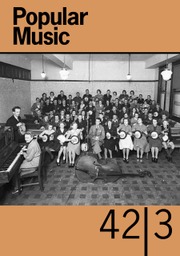Crossref Citations
This article has been cited by the following publications. This list is generated based on data provided by Crossref.
Holmes, Su
2004.
“Reality Goes Pop!”.
Television & New Media,
Vol. 5,
Issue. 2,
p.
147.
Meier, Leslie M.
2008.
In Excess? Body Genres, “Bad” Music, and the Judgment of Audiences.
Journal of Popular Music Studies,
Vol. 20,
Issue. 3,
p.
240.
Homan, Shane
2008.
An ‘Orwellian vision’: Oz Rock scenes and regulation.
Continuum,
Vol. 22,
Issue. 5,
p.
601.
Kuppens, An H.
2009.
Authenticating Subcultural Identities.
Journal of Communication Inquiry,
Vol. 33,
Issue. 1,
p.
43.
Ho, Tung‐hung
2009.
Taike rockand its discontent.
Inter-Asia Cultural Studies,
Vol. 10,
Issue. 4,
p.
565.
WALTZ, MITZI
and
JAMES, MARTIN
2009.
The (re)marketing of disability in pop: Ian Curtis and Joy Division.
Popular Music,
Vol. 28,
Issue. 3,
p.
367.
Wilsmore, Robert
2009.
The Last Performance [dot org]: an impossible collaboration.
Journal of Writing in Creative Practice,
Vol. 2,
Issue. 1,
p.
15.
MATTAR, YASSER
2009.
Popular cultural cringe: language as signifier of authenticity and quality in the Singaporean popular music market.
Popular Music,
Vol. 28,
Issue. 2,
p.
179.
Emmerson, Jean
Rinta, Tiija
Anderson, Joseph
Wilde, Howard
and
Oliver, Rowan
2010.
Reviews.
Journal of Music, Technology & Education,
Vol. 3,
Issue. 1,
p.
67.
Dolan, Emily I.
2010.
‘… This little ukulele tells the truth’: indie pop and kitsch authenticity.
Popular Music,
Vol. 29,
Issue. 3,
p.
457.
HIRSCH, LILY E.
2010.
“Playing for Change”: Peace, Universality, and the Street Performer.
American Music,
Vol. 28,
Issue. 3,
p.
346.
Scahill, Adrian
2010.
The Irishness of Irish Music.
Ethnomusicology Forum,
Vol. 19,
Issue. 1,
p.
124.
Weisethaunet, Hans
and
Lindberg, Ulf
2010.
Authenticity Revisited: The Rock Critic and the Changing Real.
Popular Music and Society,
Vol. 33,
Issue. 4,
p.
465.
SLATER, MARK
2011.
Timbre and Non‐radical Didacticism in the Streets' A Grand Don't Come for Free: a Poetic‐Ecological Model.
Music Analysis,
Vol. 30,
Issue. 2-3,
p.
360.
Chastagner, Claude
2011.
De la culture rock.
p.
263.
Meier, Leslie M.
2011.
Promotional Ubiquitous Musics: Recording Artists, Brands, and “Rendering Authenticity”.
Popular Music and Society,
Vol. 34,
Issue. 4,
p.
399.
Girard, Stéphane
2011.
(Un)originality, hypertextuality and identity in Tiga's ‘Sunglasses at Night’.
Popular Music,
Vol. 30,
Issue. 1,
p.
105.
Parham, John
2011.
A CONCRETE SENSE OF PLACE: ALIENATION AND THE CITY IN BRITISH PUNK AND NEW WAVE 1977–1980.
Green Letters,
Vol. 15,
Issue. 1,
p.
76.
Le Guern, Philippe
2012.
Irréversible ?.
Réseaux,
Vol. n° 172,
Issue. 2,
p.
29.
Keister, Jay
Rudy, Dario
and
Hylton, Laura
2012.
« The Long Freak Out » : musique inachevée et folie contre-culturelle dans le rock d’avant-garde des années 1960 et 1970.
Volume !,
Vol. 9 : 2,
Issue. ,
p.
69.

